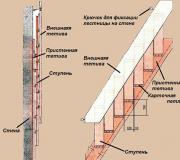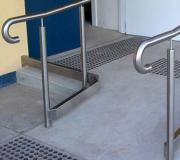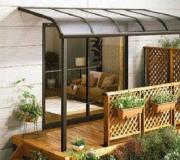How to make a canopy from polycarbonate. Polycarbonate canopy drawing
Polycarbonate is an innovative building material that has already become quite popular. In a short time on the market, he pressed the film, glass and wood, which were so recently in demand. At first, polycarbonate was used only in the country for the construction of greenhouses and greenhouses due to the fact that it perfectly transmits sunlight, has a good margin of safety and is easy to install. But later landscape designers paid attention to its other advantages.
Why polycarbonate
When designing the territory of a suburban area, one of the most pressing issues is the arrangement of a comfortable recreation area, which would be located outside the house, somewhere on the lawn, as well as shelters for the car. These problems can be solved in different ways. But the main one is still the construction of the pavilion. A polycarbonate canopy is the easiest to make, besides, it is not necessary to call a master - everything can be made by hand. In addition, this design provides its owner with maximum benefits.
Material types
So far, only two types of polycarbonate are known that are used for the construction of canopies - this is a cellular and monolithic thermoplastic. The first is a panel consisting of several layers of transparent or matte plastic, which are interconnected by vertical stiffeners located along the fibers of the material. At the same time, the voids are filled with air, which gives polycarbonate excellent thermal insulation properties. Cellular sheets bend well even in the usual, so-called cold state. Therefore, a polycarbonate canopy can be made even of the most complex and bizarre shape.
Monolithic polymer has its advantages. It absorbs ultraviolet well and has rich colors, and for all its strength it has a fairly light weight. It is used not only in construction, but also in other industries, which include high-tech systems.
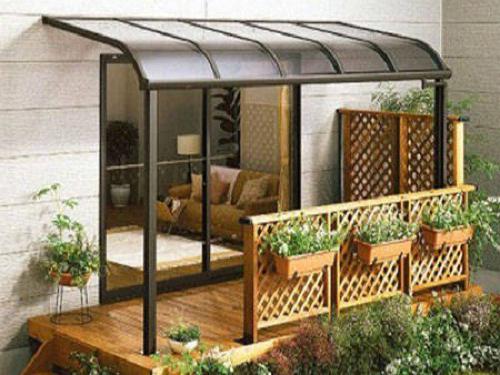
The advantages of this material
A polycarbonate canopy can be of any design, but each of them will have clear advantages that should be mentioned. And the most important thing is the durability of the structure. Also very important is the fact that this material is easy to install and does not require any special care. It provides high transparency or opacity of the structure, depending on the need, and also performs protective functions against harmful effects.
The material is beautiful and, importantly, it is produced in a wide range of colors. And another very important aspect is the low cost. Canopies made of polycarbonate, the price of which varies depending on the size, will still be cheaper than those made of wood or metal. One sheet of material costs from 1,400 to 10,750 rubles. Such a spread in prices is due to its size and thickness.
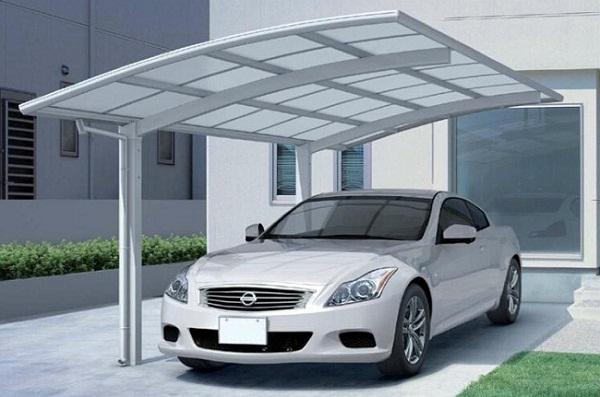
How to choose
When deciding which polycarbonate to purchase, you need to decide on three parameters. These are thickness, color and quality. In order to do this correctly, you need to determine the purpose of the building. To select the thickness of the material, snow and wind loads are taken into account, as well as the crate step. A few practical tips about this will not interfere:
- four-millimeter sheets are suitable for arranging greenhouses, greenhouses, as well as various advertising structures;
- from a plate of 6-8 mm, you can make a partition, a roof, a canopy or a canopy to the house from polycarbonate of your chosen color;
- a 10 mm panel is usually used for the construction of vertical surfaces;
- slabs with a thickness of 16 mm or more are suitable for buildings that must withstand truly huge loads, such as car parks.
As for the color, this is also a very important nuance, since the color of the plates can be of different intensity and transparency. For example, sheets of turquoise, blue and green are suitable for a canopy over the pool. But these tones cannot be used as a visor above the sales counter, because they will distort the original color of the goods placed inside.
The quality of polycarbonate depends only on its manufacturer. Products of well-known companies are always distinguished by reliability and environmental safety, and also have a protective layer against ultraviolet radiation, which is applied to the front surface of the sheet.
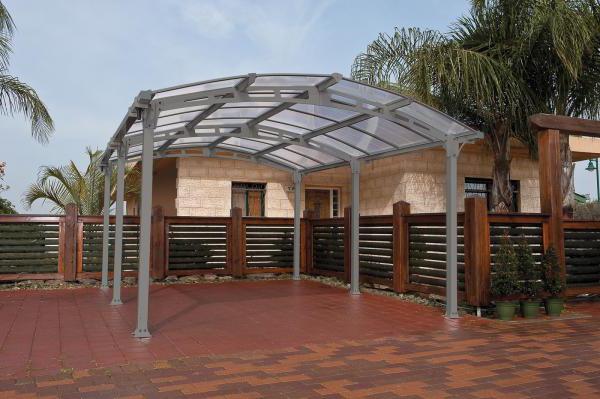
Necessary tools and materials
To install a polycarbonate canopy with your own hands, you need to make a calculation and purchase everything necessary for the production of these works. You will need the following materials:
- press washers and (the latter will be useful only when the pavilion will be installed on a hard surface);
- self-tapping screws with galvanized coating;
- a mixture of cement, sand and gravel, if necessary, mount racks for support;
- pipes for the manufacture of support pillars with a square section of 60 x 60, 80 x 80 or 100 x 100 mm;
- cellular boards with a thickness of 8 to 10 mm;
- pipes for lathing with a section of 20 x 40 mm and for runs - 40 x 60 or 60 x 60 mm;
- a load-bearing arch that you can make yourself, but you must remember that in such structures you need to withstand a ten-degree or greater angle of inclination of the roof.
Tools that will be needed for the production of work: a welding machine, a screwdriver, a circular disc with discs, a level and a shovel.
Calculations
Very often, the owners of country houses do not invite craftsmen, but prefer to do almost everything on their own. In order to quickly and beautifully carry out work on the arrangement of the territory, you need to know how to make a polycarbonate canopy yourself.
Before work begins on the installation of such a structure, it is necessary to make its project with drawings. To do this, you need to calculate the size of the frame and the load that it will withstand, taking into account the level of precipitation and typical for your region. Based on this, the necessary material is selected. A simple drawing of a polycarbonate canopy is presented in this article.

Installation of the structure, the first stage
During the construction of a canopy, the main thing is the marking of the site where it will be located. After that, they dig recesses 0.5-1.5 m long, in which frame racks will be mounted. The depth of the pits depends on the height of the pavilion itself. In them I install the parts to which the frame racks will be attached, pour them with concrete. Next, the soil is removed over the entire territory of the canopy to a depth of 10-20 cm, and instead of it, the so-called pillow of sand and gravel is poured, and it is carefully rammed. Then they lay the finish coating in the form of a lawn grate, paving slabs, or simply make a concrete screed.
A polycarbonate yard canopy is usually mounted on a frame made of material that has already been used for other outbuildings to maintain the style of the interior. The basis can be wooden, aluminum or steel blanks.

second phase
The final stage of the installation is the fixing of the sheets. First you need to prepare the panels of the desired size (see the drawing of the polycarbonate canopy). To do this, they are cut with tools. In this work, it is important that after cutting the length of the plate should be 10-15 cm longer than the perimeter of the arch. It is important to know here that after cutting the polycarbonate sheet, the protective film applied on its front side should not be removed.
Now you need to attach the bottom of the profile to the arch so that its step is equal to the layout of the sheets. Next, fix the panels with self-tapping screws. To do this, drill holes 2 mm smaller than the seat size of the press washer itself. Then screws are screwed, and their hats are hidden under protective caps.
After two adjacent plates are fixed, the docking profiles are closed with a lid. At the very end of the installation, the side parts of the sheets must be protected. This is done by installing end profiles, which are fixed either with self-tapping screws or glued.

